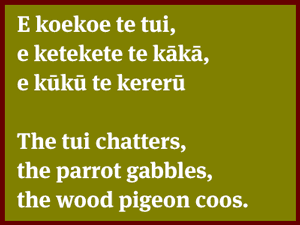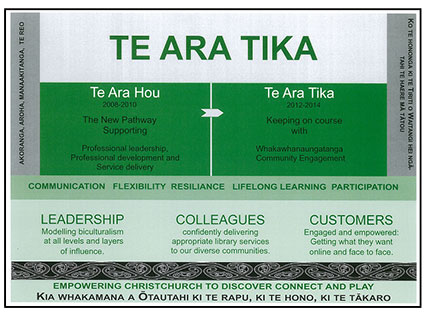Diversity starts with an authentic bicultural partnership

It takes all kinds of people ...
Download Te Ara Tika [374KB PDF]
Mihi
E ngā mana, e ngā waka, e ngā hau e wha e te iwi whānui
Tēnā koutou
He mihi whānui atu tēnei nā Ngā Kete Wānanga o Ōtautahi
Tēnā koutou katoa
Ko te tūmanako, kia nui ai ngā hua o tēnei mahi, kia puāwaitia anō te mahi o ‘Te Ara Hou’ hei kete rauemi mō te iwi whānui katoa.
The spiritual ethos, the canoes, the four winds to all people
Greetings
A very warm welcome from Christchurch City Libraries
Greetings to you all
It is our hope that the fruits of this report will be significant, so that the work of ‘Te Ara Hou’ can once again flourish as a resource for the iwi.
Te Wā o Ruaumoko
During the 2010-2011 (earthquake) period we were confronted with some major challenges. New demands from impacted communities were made on our already dwindling library collections. Some of these emerging demands have impacted on bicultural services bringing with it many requests from local schools, Marae and community groups. The Māori services team were tasked with filling the gaps by working alongside these organisations to continue to engage and offer whatever support we could. While it was a time of uncertainty and turmoil, it was also an opportunity to discover new ways of working together more efficiently by sharing knowledge, expertise, resources and venue spaces.
Matakite/Vision
Creating a new bicultural vision post–earthquake was not an easy task given that our resources were severely depleted and the demands on the Māori services team were stretched to the limit assisting colleagues across the Libraries network to get things up and running again. Local marae became important community hubs and our drive and focus was redirected to awhi and support those communitites.
It was very clear to us during this period where our resources and energies needed to focus and so Te Ara Tika our new bicultural plan emerged as the pathway to keep us on the right track.
Te Ara Tika 2012 – 2014 is Christchurch City Libraries refreshed bicultural strategy expanding on the existing plan Te Ara Hou, to support Māori culture and heritage as the distinct core of New Zealand’s bicultural identity. It is a strategy to find innovative pathways to achieve the information and learning needs of Tangata Whenua and to be relevant to New Zealand society.
We believe that diversity starts with an authentic bicultural partnership and our broad goals for Te Ara Tika focus on the following areas:
- Resource development to support future learner (staff and customer) needs
- Ngā Pounamu Māori Collection redevelopment and access by preserving our culture and heritage for the enjoyment of future generations
- New Library development supported to reflect diversity of our future communities in the rebuild of the city
- Recruitment strategies to ensure that our staff appointments reflect our diverse community
- Actively respond to the Programme, Events and Learning activities across the Libraries to ensure the inclusion of cultural activities.
- Continue to support and provide cultural digital content for the library website and social media network
Te Ara Tika 2012 – 2014 has a mixture of business as usual and emerging new directions. It will focus on the changes in Cultural Service Delivery with more resource directed to Outreach and Digital Services and a continued push forward for the cultural professional development needs of Library colleagues.
Supporting frameworks that provide direction and influence are:
- TAT is strategically positioned to deliver on the CCC draft Community Outcomes 2013 – 2022 “Strong Communities”
People have a sense of connection to and participate in their community
Cultural and ethnic diversity is valued and celebrated - The CCC Annual ‘Performance Review and Development’ process is used to capture individual staff objectives and competencies to deliver on Te Ara Tika objectives and directions consistent with Community Services ‘Plan On A Page’ priorities
- Te Ara Tika aligns with the vision, roles and outcomes identified in the Public Libraries of NZ, Strategic Framework 2012–2017.
- Directions for Education Renewal in Greater Christchurch will require innovative and improved community engagement and will open up opportunities for CCL to have a greater input into assisting and empowering Community Learners. Plans for a Community campus in Aranui have been proposed and are well underway.
The following three pathways within the Te Ara Tika framework will guide and encourage staff and community participation during this difficult period of renewal and redevelopment: Leadership – Colleagues – Customers.

Beyond 2014
Building strong trusting relationships with Iwi now and into the future is more important than ever, with the growing asset base in a post–Treaty settlement environment bringing more focus to bear on iwi and Māori economic contributions to New Zealand. Exploring fundamental cultural considerations, processes and strategies for engagement, and business developments and opportunities for involvement and collaboration.
Key focus areas
- Strategic leadership and collaboration
- Strengthening cultural understanding and integrity
- Evaluating engagement platforms and strategies
- Identifying future opportunities
- Achieving meaningful engagement
- The future of Te Reo Māori
- Māori business and economic development
- Treaty settlements and the 2014 timeline
One new piece of work for consideration is the development of a new model beyond Te Ara Tika, a broadening of scope for Māori and Cultural service delivery. Of particular relevance is the changing face of the Christchurch population with increasing ethnic diversity on the rise.
A recent report from Statistics NZ showed that the ethnic diversity of the New Zealand population is growing at a rapid rate. This is being reflected in the workforce and will continue to do so. While the majority of the population falls into the ‘European or Other’ category, it is projected to increase by just 0.4% a year. Other ethnic groups are expected to more than double that growth until 2026:
- New Zealand Māori – 1.3% a year, from 620,000 in 2006 to 810,000 in 2026
- Asian –3.4% a year, from 400,000 in 2006 to 790,000 in 2026
- Pasifika – 2.4% a year, from 300,000 in 2006 to 480,000 in 2026
This reflects changing workforce, bringing a host of new opportunities and challenges for leaders. We need to be prepared and better equipped to manage this effectively. We will need to establish a workplace culture that embraces diversity and flexibility because diversity in the workforce is an asset and is the one true thing we all have in common.
Christchurch to grow in diversity Olivia Carville, The Press 30 July 2012
Christchurch will be snapping at Auckland’s heels as the most ethnically diverse city in the country when thousands of migrants flood in for the rebuild, a sociologist says. Massey University Professor Paul Spoonley said the earthquake–hit city would ‘leapfrog’ from one of New Zealand’s least ethnically diverse cities to a top contender for the title over the next 18 months. The ‘unparalleled’ influx of construction migrants into Christchurch would result in the Garden City’s streets looking a lot more like Auckland, he said.
The people of Christchurch have got to understand that there are going to be very different faces on the streets soon. It’s going to be a very different city in a few years and it is important they adjust to that.Spoonley, who has researched immigration and employment issues in New Zealand for the past three decades, believed the size of the influx could lead to the country’s third major immigration wave.The proportion of ethnic groups in the city will rise quite rapidly and quite fast. It’s going to change the cultural mix and transform the community. The professor raised concerns over how to adequately prepare Cantabrians for the ‘culture shock’, how ‘welcoming’ the community would be to the thousands of migrants and how to ensure employers understood the need for diversity.
Christchurch is going to need to rebuild in a social sense as well as a physical sense. You need champions for the rebuild, you need champions for worker recruitment and I think you will need champions for making Christchurch a welcoming city,he said.
With this new model come new opportunities to expand our delivery of culturally appropriate services and resources. This will require robust systems to support the following Key Drivers:
- Draft Community Outcomes 2013 –2022 ‘ Strong Communities’. People have a sense of connection to and participate in their community. Cultural and ethnic diversity is valued and celebrated.
- People have the information and skills to enable them to participate in society.
- Learning and Literacy.
- Public Programming.
The Māori and cultural services rōpū is part of the wider Libraries Programme Events and Learning Team. We have many successful strategies and processes of partnership and participation and would be well placed to led the way for a possible new model.
Christchurch City Libraries, Ngā Kete Wānanga o Ōtautahi will be an active partner in building relationships based on honesty, trust and integrity (tika and pono) ; compassion and caring (aroha and manaakitanga); and recognition of diversity. Everybody is able to participate, Māori and Pasifika peoples, Refugees and New Migrants. Everybody has access to appropriate and affordable Library Services. We support our children/tamariki mokopuna, young people/rangatahi, our older adults/pakeke and kaumātua and their families/whānau, through innovative Library learning programmes, events and services.


